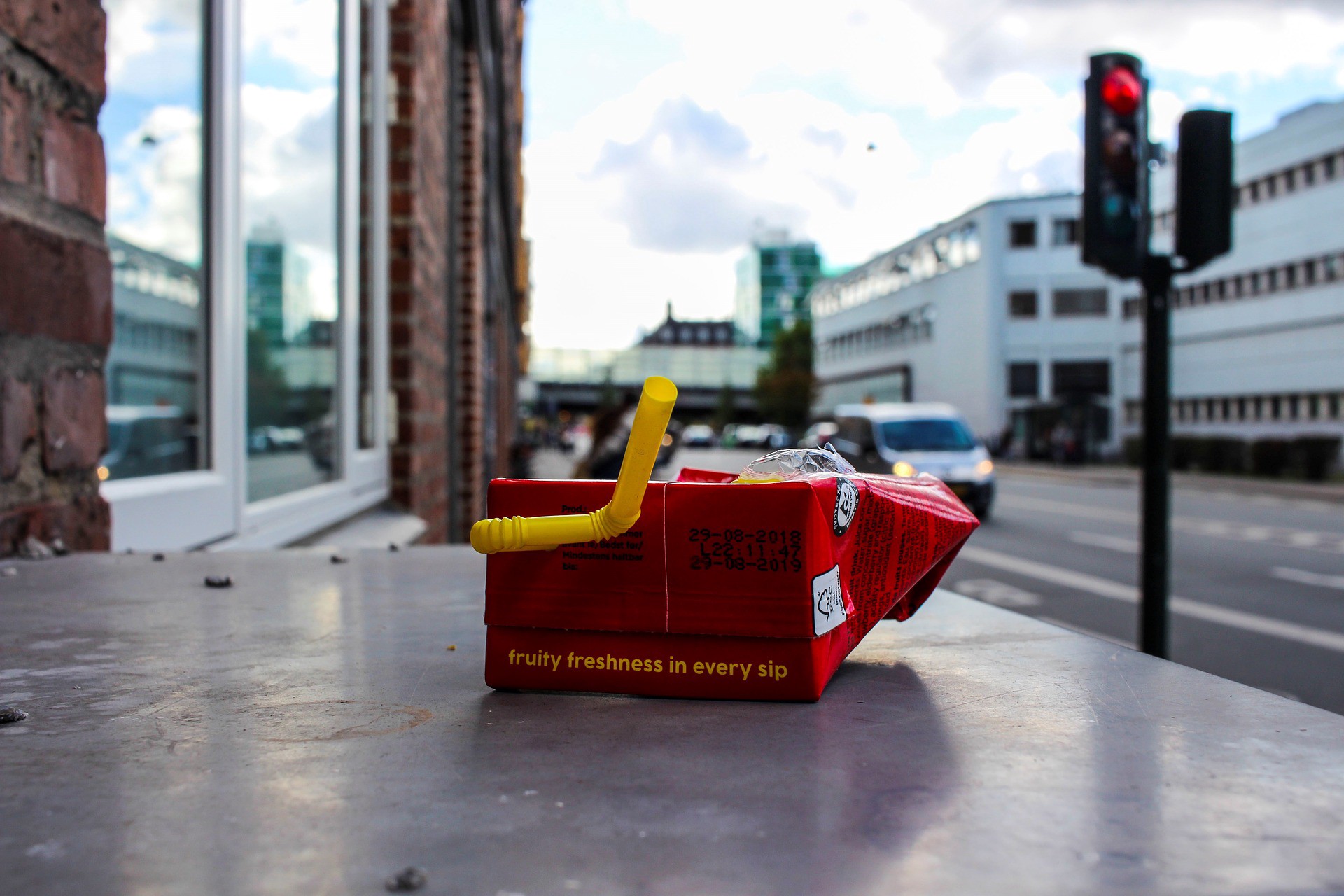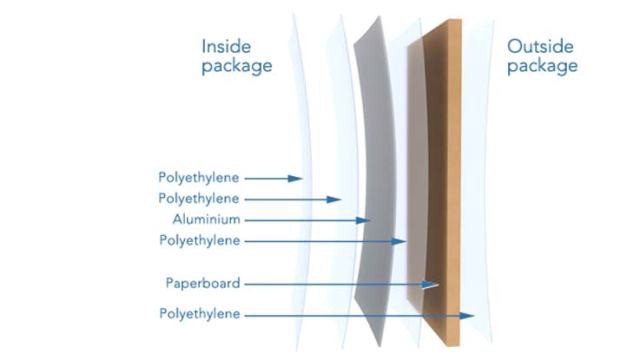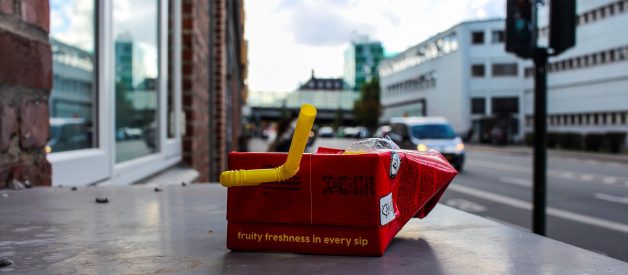A discussion about the pros and cons of Tetra Paks.
 Image by Linus Schtz from Pixabay
Image by Linus Schtz from Pixabay
I?ve been actively avoiding disposable straws. A few days ago, I thought I?d indulge in a packet drink. It was one of the little Tetra Pak packs with a little straw in a thin plastic sheet stuck to its side.
I pulled the straw out, stuck it into the foil hole on top of the pack, then realized stupidly that that?s a straw. In my mind, I saw a sea turtle with said straw stuck in one nostril. Ugh.
I had somehow overlooked the straw. And seeing the straw made me wonder about Tetra Pak recycling. Yes, I see the recycling symbol, but how recyclable is it? Is it sustainable? What about the straw and the thin plastic film?
Tetra Pak is a Swedish company specializing in food packaging and processing. I?m sure you?ve seen a Tetra Pak, and you?ve most likely drunk from one. They?re used to package everything from little packets of milk to soup to juices and larger cartons of milk.
Light and boxy, they have the lowest carbon footprint compared to other packaging
According to a paper, carton packaging has the lowest overall carbon footprint compared to glass bottles, aluminum, and steel cans, and plastic bottles, ranging from 90?111kg CO2e/1000 liters of beverage. The glass bottle has the highest carbon footprint, ranging from 150?761kg CO2e/1,000 liters.
This is owing to the fact that Tetra Paks have a lighter weight in comparison to the other materials and require lesser energy to manufacture.
Because they?re boxy, they can be packed close together and less material is needed to package them. Up to 33% more Tetra Pak cartons can be transported in the same amount of space as compared with the other types of packaging, resulting in lower carbon emissions.
However, its lightness is also the cause of its problems. The Tetra Pak is light because it?s made with thin layers of polyethylene, paper and aluminum fused together. Hence, special equipment is required to recycle them.
There are two main types of Tetra Pak cartons: aseptic and non-aseptic cartons. Aseptic cartons are shelf-stable and contain a layer of aluminum for added protection. Non-aseptic cartons do not have a layer of aluminum and require refrigeration.
 Layers, Tetra Pak packaging material. Credits to Tetrapak.com.
Layers, Tetra Pak packaging material. Credits to Tetrapak.com.
A typical aseptic Tetra Pak carton is 75% paperboard, 20% polyethylene and 5% aluminum.
Not accepted by every recycler
According to the Tetra Pak website, it?s 100% recyclable. The problem is, it?s 100% recyclable only when you send it to recyclers with the machinery to handle them. Unfortunately, not every recycler has the ability to recycle cartons.
Sure, we can mail our used cartons to carton recyclers if there isn?t one in our part of town. I?m just not sure how many of us would do that. In Singapore, even though Tetra Pak cartons are accepted in our islandwide recycling program, many of us still throw them in the trash.
In 2018, Tetra Pak?s global recycling rate is 26%. Their target is to increase recycling rates to 40% this year, but they face a lot of challenges.
For instance, in countries like Vietnam, there?s only one company recycling Tetra Paks and there isn?t a collection system for used cartons, so recycling is fraught with difficulties. Since it costs too much for the recycler to collect used cartons from consumers, the recycler only recycles Tetra Paks sent to them from affiliated companies. As a result, the recycling rate in Vietnam is very low, and Tetra Paks are a significant source of pollution.
Given that Tetra Paks are available globally, the fact that the infrastructure and system for collection and recycling of their cartons aren?t widely available, while understandable, poses a huge environmental problem.
Virgin paper and plastic used
To give its cartons a strong structure, Tetra Pak only uses virgin fibers in its production. Yes, every Tetra Pak you came across came from a tree. To their credit, Tetra Pak uses Forest Stewardship Council certified paper in all its products. Unfortunately, we have to remember that 60?70% of Tetra Pak cartons aren?t recycled at the moment.
It?s also worthy to note that paper, though a renewable resource, can only be recycled between 5 to 7 times. But, at least it?s biodegradable!
As for plastic, it can only be downcycled. Eventually, it?ll end up as waste that doesn?t biodegrade.
The plastic and aluminum polymer in Tetra Paks are sometimes recycled into roofing materials. Then again, the usefulness of these materials depends on how widely used they are.
Sustainability of Tetra Pak
Like most materials out there, there?s never a straightforward answer to whether a product is sustainable or not. I think Tetra Pak does put thought into sustainability and the low carbon footprint of the Tetra Pak makes it an attractive solution to our packaging problems.
However, the problems seem to outweigh the advantages. They need to ensure that the system and infrastructure for collecting and recycling used Tetra Paks are in place for all their markets.
Even then, we should keep in mind that we already have a plastic pollution problem that?s growing bigger each day.
The thin polyethylene in each carton may not seem like much, but multiply it by the millions of cartons used each day, and it?s a huge quantity.
Besides, we don?t know what the quality of the plastic recycled from Tetra Paks is like. Would all that plastic become waste in a cycle or two? In my opinion, it?s still better to keep the fossil fuels in the ground, rather than turn them into plastic.
Why Recycling Plastic Doesn?t Solve Plastic Pollution
It?s dangerous to think that recycling plastic is sufficient to deal with the plastic pollution problem. Here?s why.
medium.com
The alternatives
The alternative materials to Tetra Pak include glass, steel, aluminum, and plastic. I?d say take plastic off the list.
I love glass, steel, and aluminum because they?re completely recyclable ? they can be recycled over and over with no loss of quality. They?re also widely recycled in most countries so there?s no need to build new infrastructures and set up new collection systems even in developing countries.
However, they do have a higher carbon emission from their manufacturing and transportation processes than Tetra Paks. So the impact of these materials on the environment is highly dependent on whether they?re properly recycled/reused since they?re made from non-renewable resources.
To truly be eco-friendly, we?re better off making our own soups, juices and nut milk. Or buying from a bulk store with our own glass jar that we can reuse over and over. Alas, not everyone can do that!
I think the most ideal packaging changes depending on the situation. A product in a glass jar packaged in a factory near you likely has a lower carbon footprint than a product in a Tetra Pak carton flown in from the other side of the earth.
If your recycler doesn?t recycle Tetra Paks, you should use one of the other alternatives. And if you are comparing Tetra Pak with plastic bottles, choose Tetra Paks!
Personally, I?ll still choose an aluminum can of drink over a Tetra Pak drink because of its complete recyclability.
Recycling Tetra Pak, some tips
If you have to use a Tetra Pak, make sure you recycle it.
- Find out if they?re recycled in your area. For residents in the U.S., this is a nifty site to check if your community recycles cartons
- Push your straw into the carton if there?s a straw or keep the cap on if there?s a cap. Doing this prevents these little pieces of plastic from getting lost in the process of recycling (or even disposal)
- Don?t flatten them unless you?re mailing them to a recycler. Keeping them in their original shapes makes identifying them at the recycling facility easier
- They should go in the plastic, aluminum and glass bin, but check your local recycling guidelines as practices vary
I hope you?ve found this little discussion about the Tetra Pak useful. For now, I?ve decided to quit drinking from individual-sized Tetra Paks ? that?s definitely not worth it.
That said, I?ll probably still buy plant-based milk in cartons until I figure out how to make and store my own nut milk properly? And make sure I recycle the cartons.
What are your thoughts on the Tetra Pak? Would you choose it for its lower carbon footprint or would you avoid it to avoid plastic and paper use? Let me know!
Originally published at https://darkbluejournal.com on February 18, 2020.


